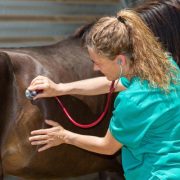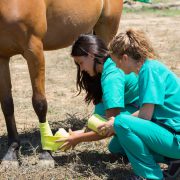Treatment of equine sarcoids: A systematic review
Treatment of equine sarcoids: A systematic review

our summary:
Offer, K.S, Dixon, C.E. and Sutton, D.G.M. (2023) Treatment of equine sarcoids: A systematic review. Equine Veterinary Journal
The aim of this systematic review was to examine the quality of available evidence for the treatment of sarcoids in equids with the intention of developing guidelines for the treatment of sarcoids and to highlight any gaps in the current evidence.
Published papers were identified following a literature search carried out in April 2021 on five databases. Inclusion criteria were an interventional study examining a sarcoid treatment strategy, where the case definition of sarcoid was confirmed by histopathology in at least some of the included cases, and where there was a minimum of six months follow-up on treated cases. Studies also needed to be of level four, in the OCEBM Levels of Evidence, or above, e.g. case series or greater, in the hierarchy of evidence.
Following screening ten papers were included in the review, four randomised clinical trials (RCT), three prospective non-randomised clinical trials and three retrospective studies. Case definition was confirmed via histopathology in all included lesions in 60% of papers. Eight papers lacked untreated or placebo controls whilst in only one paper were those administering treatments blinded to the treatment protocol. Time to follow-up varied but was up to 120 months in some cases. Sarcoid types varied between studies but generally included all clinical morphological categories on all regions of the body.
Risk of bias, assessed via Cochrane Groups risk of bias tools, ranged from ‘some concerns’ to ‘critical’. For RCTs the main concern was bias in the randomisation process or lack of blinding. In the non-randomised studies bias arose due to baseline confounding and from lack of blinding in the assessment of outcomes. Using a GRADE approach to assess the evidence the authors concluded that the certainty of evidence was low or very low for the majority of treatments.
There was a very wide range of sarcoid regression rate both on an individual sarcoid and whole horse level, the most effective treatment regimes were radiotherapy, cryotherapy, intralesional cisplatin or electrochemotherapy where complete regression rates of >90% were reported. Transient local inflammation was recorded following most treatment strategies, other significant adverse events were generally restricted to individual cases.
Limitations of the study included the small number of studies available that addressed the treatment of sarcoids in equids and that the quality of evidence in the available studies was low. Lack of heterogeneity between included papers limited the available synthesis.
This systematic review highlights the lack of high quality studies in this area meaning that there is insufficient evidence to recommend on sarcoid treatment over another. Further studies are needed to allow a more definitive comparison of the efficacy of different treatment strategies to be made.
The following may also be of interest:
Hollis, A.R. (2023) Management of equine sarcoids. The Veterinary Journal, 291 no. 105926. https://doi.org/10.1016/j.tvjl.2022.105926
Knottenbelt, D.C. (2019) The equine sarcoid: Why are there so many treatment options? Veterinary Clinics of North America: Equine Practice, 35 (2), pp. 243-262. https://doi.org/10.1016/j.cveq.2019.03.006
Claiming CPD for reading inFOCUS articles
Reading and reflecting on articles can count towards your CPD, and we have a template to help you with the process.
Image copyright attribute: djakob
Join the discussion
We encourage discussion on all material highlighted in each edition of inFOCUS. Use the button below to join the conversation on Twitter and include your comment in the feed for this issue.










Leave a Reply
Want to join the discussion?Feel free to contribute!